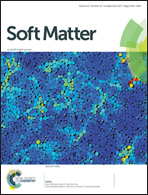Chevrons, filaments, spinning clusters and phase coexistence: emergent dynamics of 2- and 3-d particle suspensions driven by multiaxial magnetic fields†
Abstract
In recent years a rich variety of emergent phenomena have been observed when suspensions of magnetic particles are subjected to alternating magnetic fields. These particle assemblies often exhibit vigorous dynamics due to the injection of energy from the field. These assemblies include surface and interface phenomena, such as highly organized, segmented “snakes” that can be induced to swim by structural symmetry breaking, and “asters” and “anti-asters,” particle assemblies that can be manipulated to capture and transport cargo. In bulk suspensions of magnetic platelets subjected to multiaxial alternating fields, advection lattices and even vortex lattices have been created, and a variety of biomimetic dynamics – serpents, bees and amoebas – have been discovered in magnetic fluids suspended in an immiscible liquid. In this paper several new driven phases are presented, including flying chevrons, dense spinning clusters, filaments, and examples of phase coexistence in driven phases. These observations broaden the growing field of driven magnetic suspensions and present new challenges to those interested in simulating the dynamics of these complex systems.


 Please wait while we load your content...
Please wait while we load your content...